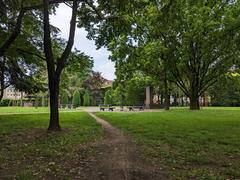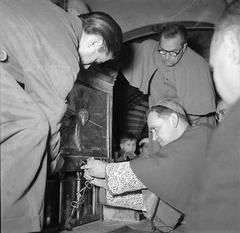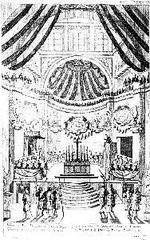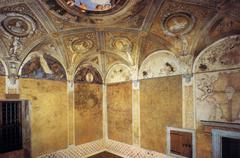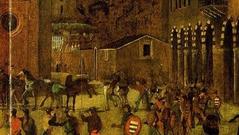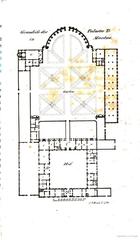
Cortile Della Mostra: Visiting Hours, Tickets, and Historical Sites in Mantua, Italy
Date: 04/07/2025
Introduction
Nestled within Mantua’s renowned Palazzo Ducale, the Cortile della Mostra—also known as the Cortile della Cavallerizza—stands as a striking example of Renaissance and Mannerist architectural mastery. This historically significant courtyard reflects the grandeur of the Gonzaga dynasty and has served, since the 16th century, as a locus for courtly exhibitions, equestrian displays, and ceremonial gatherings. Its design, attributed to the likes of Giulio Romano and Giovanni Battista Bertani, embodies the harmonious proportions and inventive spirit of the Italian Renaissance.
Today, the Cortile della Mostra is fully integrated into the Palazzo Ducale museum itinerary, welcoming visitors to a meticulously restored space adorned with polychrome decorations and enhanced by modern accessibility features. Surrounded by Mantua’s other historical treasures—such as Piazza Sordello, the Basilica di Sant’Andrea, and the Castello di San Giorgio—the courtyard is an essential stop for anyone seeking to immerse themselves in the city’s cultural and architectural legacy.
This comprehensive guide details the Cortile della Mostra’s history, visiting hours, ticketing, accessibility, restoration, and practical travel tips. For up-to-date information, visitors are encouraged to consult the official Palazzo Ducale website, explore resources from the UNESCO Lab Polimi, and learn about ongoing restoration efforts at Mantovalab.
Table of Contents
- Discover the Cortile della Mostra: A Jewel of Mantua’s Palazzo Ducale
- Origins and Architectural Evolution
- Renaissance Patronage and Artistic Flourishing
- Political and Social Significance
- Transformations Through the Centuries
- Integration within Mantua’s Urban Fabric
- Practical Visitor Information
- Notable Events and Historical Anecdotes
- Restoration and Modern-Day Use
- Key Architectural Features
- Visitor Information: Tickets, Hours, and Tips
- Location and Access
- Events and Special Exhibitions
- Nearby Mantua Historical Sites
- Frequently Asked Questions
- Summary and Recommendations
- References
Discover the Cortile della Mostra: A Jewel of Mantua’s Palazzo Ducale
The Cortile della Mostra is a must-see for visitors to Mantua’s Palazzo Ducale. Its elegant arcades, decorative facades, and the recently restored suspended corridor reflect the artistic ambitions of the Gonzaga court. This space, once used for equestrian shows and grand ceremonies, is now a vibrant venue for exhibitions and cultural events.
Origins and Architectural Evolution
The Palazzo Ducale, a UNESCO World Heritage Site since 2008 (UNESCO World Heritage List), was the seat of the powerful Gonzaga family from the 14th to the 18th century (Discover Walks). The Cortile della Mostra, established in the 16th century, was designed as an internal courtyard to host courtly life, reflecting the Renaissance ideals of symmetry and grandeur.
Key architects—most notably Giulio Romano and Giovanni Battista Bertani—helped transform the complex from a medieval fortress into an exquisite Renaissance palace (Società per il Palazzo Ducale di Mantova).
Renaissance Patronage and Artistic Flourishing
The Gonzaga dynasty were prominent patrons, attracting artists and architects who left their mark on the palace. The Cortile della Mostra’s Mannerist features—twisted columns, arcades, and decorative rustication—demonstrate a shift from military architecture to spaces designed for spectacle and display. Its proximity to the Camera degli Sposi, painted by Andrea Mantegna, illustrates the palace’s broader artistic legacy (Discover Walks).
Political and Social Significance
Beyond its function as an architectural centerpiece, the Cortile della Mostra was the setting for elaborate Gonzaga festivities, tournaments, and diplomatic receptions. The space was designed to guide visitors through a carefully staged experience of Gonzaga power and sophistication, reinforcing the family’s status among European elites.
Transformations Through the Centuries
With the decline of the Gonzaga dynasty and subsequent foreign rule, the palace and its courtyards experienced periods of neglect. The 20th and 21st centuries saw renewed restoration efforts, culminating in multidisciplinary projects that have preserved and revived the courtyard’s original character (UNESCO World Heritage List; Mantovalab).
Integration within Mantua’s Urban Fabric
Located in Mantua’s historic center, the Cortile della Mostra is surrounded by a blend of medieval, Renaissance, and Baroque architecture. The city’s unique topography—encircled by artificial lakes—adds to its charm and strategic significance (Discover Walks). The courtyard connects seamlessly with other major sites, including Piazza Sordello and the Basilica di Sant’Andrea.
Practical Visitor Information
Visiting Hours
- Tuesday to Sunday: 8:15 AM – 7:15 PM (last entry at 6:15 PM)
- Closed on Mondays (except during special events)
- Always verify hours on the official Palazzo Ducale website before your visit, as schedules may change due to holidays or exhibitions.
Tickets and Entry
- Standard admission: €15
- Reduced rates: For EU citizens aged 18–25
- Free entry: For children under 18 and qualifying visitors
- Ticket purchase: Online booking is highly recommended, especially during peak periods (abbonamentomusei.it).
- Special exhibitions or events: May require additional fees.
Accessibility
- Ramps and level surfaces have been installed for visitors with reduced mobility. Some historic areas may remain challenging; contact the museum for assistance.
- Interpretive panels and audio guides are available in Italian and English.
Guided Tours
- Guided tours (in Italian and English) can be booked online or at the ticket office.
- Specialized tours focusing on restoration or architectural history are available during certain periods.
Photography
- Photography is allowed for personal use; flash and tripods may be restricted.
Notable Events and Historical Anecdotes
The Cortile della Mostra was a stage for Gonzaga court spectacles, such as the 1530 reception of Emperor Charles V, when the courtyard was transformed with theatrical decorations and performances. Today, it continues to host concerts, exhibitions, and reenactments that echo its illustrious past.
Restoration and Modern-Day Use
Restoration Highlights
Recent restoration (completed in 2024) focused on structural reinforcement, cleaning and reconstructing decorative elements, and opening up previously inaccessible areas such as the suspended corridor (Mantovalab; MantovaUno).
Innovative techniques—like 3D scanning and parametric modeling—guided minimally invasive interventions, and sustainability was prioritized through the use of traditional and modern materials.
Modern Experience
- The courtyard now hosts cultural events and serves as a focal point in the Palazzo Ducale itinerary.
- Multilingual digital guides, interactive maps, and augmented reality enrich the visitor experience.
Key Architectural Features
- Spatial Organization: Elongated rectangular plan with harmonious proportions (UNESCO Lab Polimi).
- Facade Treatments: Mannerist elements by Giulio Romano—twisted columns, rusticated stone, and dynamic arches (Società per il Palazzo Ducale di Mantova).
- Integration: Connects key palace spaces, linking the Appartamento Grande di Castello, Corte Nuova, and Palazzina della Rustica.
Location and Access
- Address: Piazza Sordello, 40, 46100 Mantova MN, Italy
- Getting there: Easily accessible on foot from the city center; Mantua’s central train station is a 20-minute walk away (shegoesthedistance.com).
- Parking: Limited in the historic center. Parcheggio di Campo Canoa offers free parking and a shuttle into the center (asprinkleofitaly.com).
Events and Special Exhibitions
The courtyard hosts exhibitions, performances, and themed reenactments throughout the year. Check the events calendar for updates before planning your visit.
Nearby Mantua Historical Sites
- Camera degli Sposi with Mantegna’s frescoes
- Zodiac Room
- National Archaeological Museum (featuring the “Lovers of Valdaro” skeletons)
- Piazza Sordello and St. Peter’s Cathedral (shegoesthedistance.com; The Italy Edit)
Frequently Asked Questions (FAQ)
How can I purchase tickets?
Tickets can be bought online or at the Palazzo Ducale ticket office. Online purchase is recommended.
What are the visiting hours?
Tuesday to Sunday, 8:15 AM to 7:15 PM, last entry at 6:15 PM. Closed on Mondays.
Is the courtyard accessible for visitors with reduced mobility?
Yes, with ramps and level surfaces, though some historic areas may be less accessible.
Are guided tours available?
Yes, in Italian and English. Audio guides are also available.
Can I take photographs?
Yes, for personal use. Flash and tripods may be restricted.
Summary and Recommendations
The Cortile della Mostra stands as a restored masterpiece of Mantua’s Renaissance heritage—a space where architecture, art, and history converge. With updated visiting hours, ticketing options, and accessibility features, the courtyard remains open and inviting to all. Its connection to other Mantua historical sites and cultural programming makes it a highlight of any visit to the city.
Tips for Visitors:
- Check the official website for the latest updates.
- Book tickets online for convenience.
- Visit in spring or autumn for the best experience.
- Engage with digital guides and virtual tours to enrich your visit.
Whether you are drawn to history, art, or architecture, the Cortile della Mostra offers a unique window into the grandeur of the Gonzaga court and the enduring beauty of Renaissance Italy (Società per il Palazzo Ducale di Mantova).


